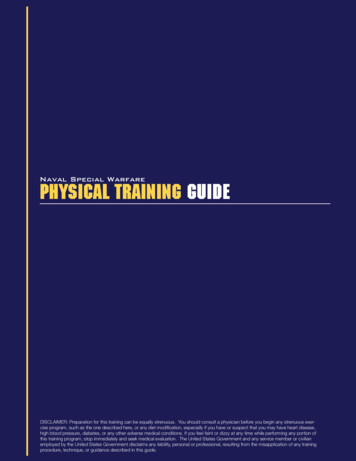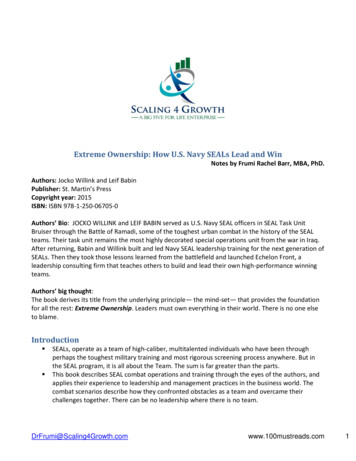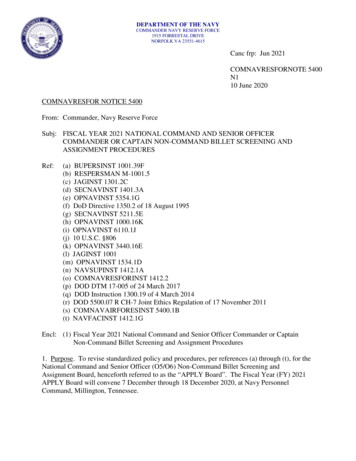
Transcription
Navy SEALs BUD/S Preparation GuideThe author and publisher have provided this e-book to you for yourpersonal use only. You may not make this e-book publicly available inany way. Copyright infringement is against the law. If you believe thecopy of this e-book you are reading infringes on the author’s copyright,please notify the publisher at: us.macmillanusa.com/piracy.1
Foreword by: Brandon WebbMy favorite, and most hated question I get asked about BUD/S is, “Can you give me any tips orsecrets to making it through SEAL training?” My usual response is two words. Don’t Quit.Nobody likes a quitter, after all.I honestly believe that when you show up to BUD/S you either have it or you don’t. Admittedlythere is a degree of luck involved when it comes to injuries that produce a medical roll or dropbut you either have it in your heart and your head to succeed at all costs or you don’t. Some ofmy classmates struggled with this, and some, like myself never had an issue with being on thefringe of quitting. This doesn’t mean training was easy for me, it was one of the hardest thingsI’ve ever done. I just knew that quitting was not an option with me.This book is aimed at all types of students. The ones on the fringe will find it useful, and it maybe just the information they need to push them one way or the other. The students who realizethey would never quit it’s a book that will increase their odds at graduation because they’ll bebetter prepared, and will have some training tools to decrease the risk of over training that leadsto preventable medical injuries.There’s no secret to making it through training but being informed will make you better preparedfor what’s to come that’s the purpose of this book. The two former Navy SEAL authors bothhave experience as instructors. You’re in good hands.2
I’d also caution you to keep an open mind to the man to the left and right of you in training. Ifit’s one thing that BUD/S taught me, it’s that you cannot measure what’s in a mans heart by howmany push ups he can do, or how fast his run times are. Because heart, and strength of mind iswhat it takes to push through your perceived physical limits, and you can’t measure this on someobscure questionnaire or a PT test. You can only measure it in the arena.For those who read this book, go onto training know that there’s honor in just showing up. I’veknown some who decided that being a SEAL was not for them, and they’ve gone on to besuccessful elsewhere. You should respect these men, they had the balls to show up when manydid not, and that counts for something. For those of you who make it through the course,remember this, and this quote from TR, and be better men for it.It is not the critic who counts; not the man who points out how the strong man stumbles, orwhere the doer of deeds could have done them better. The credit belongs to the man who isactually in the arena, whose face is marred by dust and sweat and blood; who strives valiantly;who errs, who comes short again and again, because there is no effort without error andshortcoming; but who does actually strive to do the deeds; who knows great enthusiasms, thegreat devotions; who spends himself in a worthy cause; who at the best knows in the end thetriumph of high achievement, and who at the worst, if he fails, at least fails while daring greatly,so that his place shall never be with those cold and timid souls who neither know victory nordefeat. -Theodore RooseveltWelcome to the arena of life gents. Do well.3
Brandon Webb, Navy SEAL (Class 215)4
So you wanna be a Frogman Photo. 1 - Navy SEALs Urban Combat courtesy of the Official Website of the USNBecoming a Navy SEAL is something that many young American men have aspirations ofachieving. From the time they were young children running around with water guns or settingbooby-traps around the house, they have wanted to become one of America’s elite. As ateenager, they may have watched a special operations movie that lit the fire within their souls tobecome an operator. Then there are others, answering the call of duty after an event such as theterrorist attacks on September 11, 2001. If you are one of them, there are a few things you’dbetter know up front. Whether your reasoning is for patriotism, challenging yourself personally,or just because you want to be a part of one of the world’s most elite special operations units, thesame advice applies-you had better come prepared. Prepared mentally, physically and5
emotionally, or you will fall by the wayside like the other 70 % who don’t successfullycomplete the program. These percentages probably seem a bit daunting, and they are. Thisprogram is not for those lacking inner strength and mental fortitude. Becoming a SEAL is in factonly attainable if you possess a “never quit” attitude that trumps all circumstances. With the rightattitude and proper physical preparation, your odds of making it through this rigorous programwill most certainly be increased. Then too, you may be standing tall with the Navy SEAL Tridentpin upon your chest.BUD/S: What I am going to tell you here is not a matter of national security nor is it even asecret in the simple sense. The information within this book is available by means of thoroughresearch on the Internet, thanks to many years of media attention and recruiting ploys by highranking military brass. What I am going to tell you differs from your Internet research in theregard that it is straight from the mouth of one who has been through the system; a rootin, tootin,shootin Frogman.6
Photo. 2 BUD/S Students IBS Run courtesy of the Official Website of the USNAs a school or training program, whichever you choose to call it, BUD/S is truly in a class of itsown. Basic Underwater Demolition/SEAL Training takes place primarily on the sandy shores ofthe Pacific Ocean in southern California at the Naval Special Warfare Center. The averageannual daily high temperature is 70 degrees. Tourists from around the world flock to the shoresof this paradise to enjoy the sun and sand. If this sounds like a nice place to be, it is, unless youhappen to be a BUD/S candidate. For you, that balmy temperature will be tempered by manytrips into the Pacific Ocean to get wet and sandy. Although the ocean temperature averagesaround 65 degrees, I can promise you it will feel much colder after repeated visits.In my opinion, one of the primary things that sets BUD/S apart as a training program is theinstructor staff. BUD/S instructors are frogmen; they come straight from the SEAL community.7
They are VERY current on what’s going on at the Team level and with our various combat andtraining overseas. They all go through an instructor-training program both at the regular navylevel, and at the Naval Special Warfare Center. They are picked for this duty based onproficiency in their jobs, ability to teach at the Team level, temperament of personality, andperhaps most significantly, based on their remaining operational life. The final criteria Imentioned, “remaining operational life” translates to the amount of time left in a career where afrogman will be deployed overseas to do the work SEALs do. For the vast majority of instructorsthat time is still quite a bit. To put it another way; there is a VERY high chance that a graduatingBUD/S student will end up in a platoon with one or more of the instructors that put him throughtraining. We train our own. Because of this fact we, as instructors, demand an extremely highoutput level from the students. We may very well end up in combat with you, and we want toknow that the men we are sending downrange are of a quality with which we would want towork. You are being taught and graded by your eventual peers, not some outside entity with nostake in the game, or an over-the-hill relic with no more operational life. Your peers will alwaysbe your harshest and best judges.The program: It is a prescribed 24 weeks of training, divided into three unique phases ofinstruction. First phase focuses on the physical side of training, combined with shock and awemethods of instruction. Physical conditioning and strength training are the goals for the SEALcandidates while instructors weed out the weak and uncommitted. The 2nd phase, Dive Phase,consists of combat diving skills. Students learn the basics of being a combat diver, and areintroduced to two types of diving systems. The final phase of BUD/S, third phase, also known asland warfare phase, introduces the SEAL trainees to weapons and demolitions while also8
teaching the basics of navigation and small unit tactics. Although each phase has a unique goaland focus, the trainee is being exposed again and again to common challenges to ingrain in theSEAL candidate some very important attributes that will stay with him throughout his career as aNavy SEAL; team work, acquisition of new skills, attention to detail, and self-awareness.Teamwork; upon arrival at NSWC, you will already have a class number. In an ideal world, thatclass is the one you start with and the one you graduate with. That is not always the casehowever as many trainees suffer various setbacks such as injuries as well as being held back dueto performance issues. Within the class, you will be broken down into small teams called boatcrews, and further into pairs known as swim buddies. Your boat crew is where you will first beexposed to how important it is for you to be able to function at your highest level, while workingalongside six other men. If all is right in the world, those six other men are also functioning attheir highest levels and as a team, you are virtually untouchable. In reality, seldom is themachine in that pristine working order. There will definitely be times throughout the entiretraining program when you will have to take up the slack of one or more teammates or they willbe taking up your slack. Either way, the truths of the value of teamwork most often come fromthese less than perfect moments where you are being tested to your limit and have to help oneanother succeed. There is a saying at BUD/S you will hear often that exemplifies the teamworkmessage of a Navy SEAL: “You are only as strong as your weakest link.”9
Photo. 3 BUD/S Log PT courtesy of the Official Website of the USNYou will learn new skills: individual skills that you have to hone to perfection so that theybecome second nature, and, these are skills everyone has to know and be able to apply in orderfor the swim pairs, boat crews, and the class as a group to function properly. You will have toserve as a mentor and teacher within the class at times to help those who are slower oninformation uptake. In turn, you will receive assistance from your teammates as you too willstruggle and need help at times. Knot tying, small boat maintenance, boat handling; both in andout of the water, uniform standards, swimming techniques, completion of the obstacle course,study of the ocean; surf reports, tide tables, patrol formations, weapons handling, gearmaintenance, are areas you will need to master all while being tested physically. You will betested endlessly in ways you have never imagined. This will all take place in the first few weeks10
of training, nothing complicated yet, just basics, to see if instruction under stress is somethingyou can deal with undaunted. The workouts exist to test you, to stress your system whilerequiring you to do newly learned things together as a team. If you come into the system in lessthan the best shape of your life you will more than likely fall by the wayside, and watch yourclass move on without you.Attention to detail: In all phases of training, both in BUD/S and indeed during the rest of yourhopeful career as a Frogman, one of the most stressed training ideals is “attention to detail.” Thereason is simple; details are what make up complicated systems. The more complicated a system,the more details required to make it work, and any detail not fully engaged or completed willlead to the failure of the entire system. Attention to detail also has an inherent safety mechanismbuilt into it. With regards to the dangerous work we do, safety is what keeps us operational andnot undermining our own efforts. Most importantly, it is this attention to detail that will helpkeep you and your teammates alive. In the life of a Navy SEAL, there is no room for error.Losing sight or focus could get you or the man standing next to you, killed. Attention to detail isparamount; do not ever forget it.Self-awareness: This is something you will get from BUD/S in a way that is virtuallyunattainable anywhere else in life. Because of the unique structure of the training, you will begiven more opportunities for self-reflection and outside criticism than most people will get theirentire lives. People who have been in life or death situations themselves or with loved ones, andother combat vets are the only people you will ever meet who will have had the same exposure tothemselves that you will get on a regular basis throughout your training.11
Photo. 4 BUD/S Surf Torture courtesy of the Official Website of the USNFirst Phase: Physical conditioning. Has a nice, gentle ring to it doesn’t it? This is absolutely notthe case. First phase is a shocking, gut-wrenching experience. It is a unique trial, where as atrainee, you often wonder if the first phase instructors are trying to cause you more physicalharm than anything else. First phase is a test of your physical endurance, mental tenacity, andtrue teamwork skills. First phase consists of early morning physical training; uniform, gear, androom inspections; as well as timed events such as 2-mile ocean swims, 4-mile beach runs, andcompleting the obstacle course. During this phase, you will also become very familiar with all ofthe different exercises you can do with a telephone pole. The phrases “Sugar Cookie,” “SurfTorture,” and being “Beat” will be all too familiar. You will be become experts of moving the
Photo. 1 - Navy SEALs Urban Combat courtesy of the Official Website of the USN Becoming a Navy SEAL is something that many young American men have aspirations of achieving. From the time they were young children running around with water guns or setting booby-traps around the house, they have wanted to become one of America’s elite. As a











